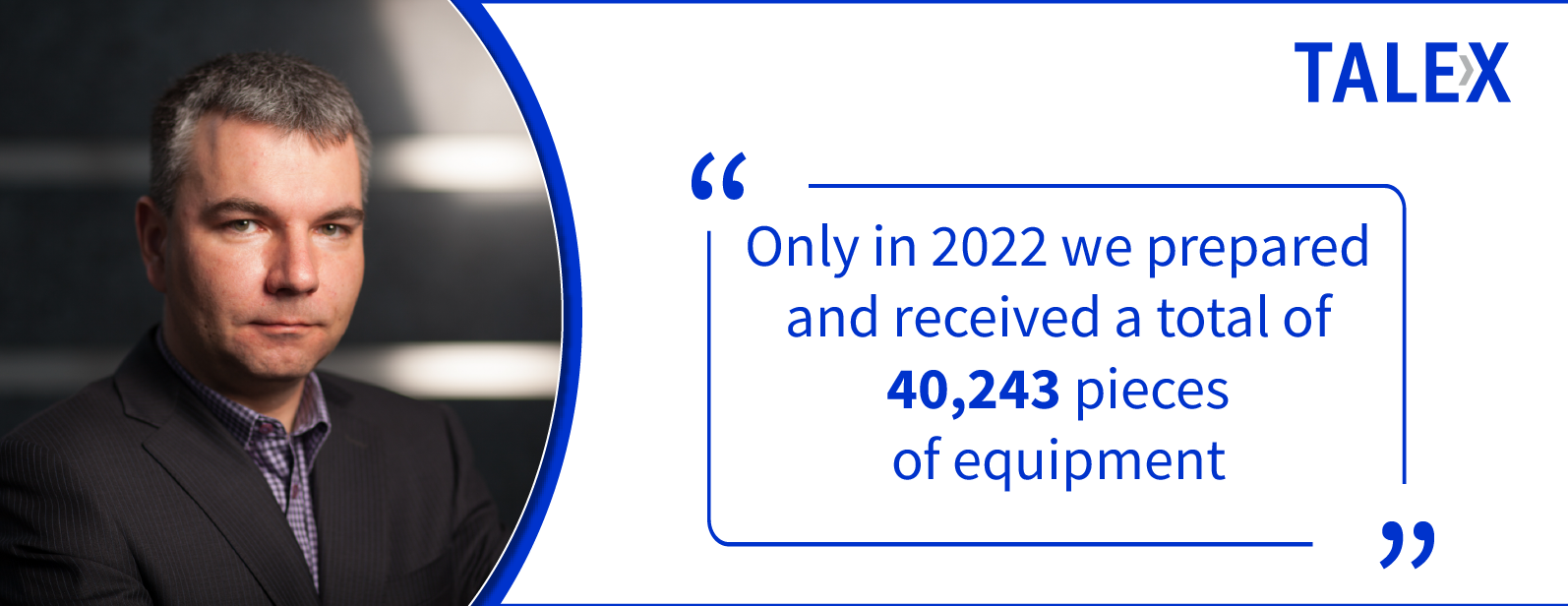A rollout service can be like a good action movie. Preparations of many months, identification of bottlenecks, a plan that is written out in the smallest detail and carried out in one weekend. The entire project is complicated, difficult and…necessary. Nevertheless, as Adrian Ziętkiewicz argues, thanks to the extensive experience of experts at Talex, you can get through the whole process unharmed.
Tell us about your professional experience.
I started working at Talex in 2000 as a system engineer, project manager, director of IT department support, and since 2012 I have been the Director of the Maintenance and Technical Support Department. My tasks include coordination of activities focused on efficient and compliant with agreements implementation of IT support for our customers, including running large implementation projects – rollouts.
How does the rollout service work?
A rollout service is, in short, a mass replacement of IT infrastructure carried out over a relatively short period of time. It can apply to part of the infrastructure (e.g. cyclical renewal of computer hardware) or the entire equipment of a given facility, depending on the specific needs of the client.
When does a client need such a service?
Basically, there are three major reasons in my opinion why clients use such a service. The first is the takeover of another organization and the subsequent need to quickly adapt its infrastructure to their own standards. This is especially evident in the case of an organization with multiple branches. The second reason is the implementation of new solutions in your own infrastructure. And the third one – the easiest to execute – is the cyclical renewal of the organization’s own IT equipment
How do you prepare for a rollout?
It depends on the complexity of the project. Renewal of equipment requires the least amount of preparations; properly written procedures and a schedule agreed with the client are enough. When it comes to the implementation of new solutions, most often we participate in their design, and we test the developed solution on a small sample, so that we make sure everything has been designed correctly. On average, we prepare for such a project for about a month, two at the most. By far, the longest preparation for a rollout we made, together with the client, was almost six months.
What are the most important factors to consider when setting the schedule and other elements of project implementation?
It is extremely important to do the entire process correctly, i.e. to plan the relevant actions. Rollouts most often require the cooperation of a few parties – the client, us, but also in many cases external companies, providers of communications, etc. We always try to identify bottlenecks in the whole process and if possible try to eliminate them. Then we are certain that the jointly agreed schedule is achievable by all parties.
What tools and methods are used to optimize the rollout process and make it successful?
We have the know-how, developed over the years. Moreover, we support our operations with a proprietary IT system, which keeps all information up to date, gives an overview of the status of the process, and facilitates its management. In the most complex rollouts, where we have several or a dozen different groups, it would be very difficult to manage a project without the whole thing being backed up by a proper system and reports on the completion of particular stages. Over the years, however, we have also learned the risks associated with such projects and the ways to minimize them.
What are the specific roles of the individual teams in the rollout process and what are the crucial skills required of these teams?
It all depends on the rollout. Most often it’s not only the deployment teams – that is, engineers with comprehensive knowledge of both networks, IT hardware and operating systems, but often it’s also the backoffice – people who plan routes, contact the end client, or conduct other support activities. Also, each rollout has a project manager on both sides, and it is often their cooperation that determines the smooth execution of the entire project.
Is there any rollout that you remember in particular? What happened back then?
The previously mentioned rollout, for which we had been preparing for almost half a year, was related to our client from the financial sector taking over the retail part of another bank. The project was complicated in that the whole thing had to be completed in one particular weekend – which was the requirement of the Financial Supervisory Commission. More than a hundred branches and almost a thousand employees at the central office had to be connected to the new organization within two days. And there was simply no time for the implementation of the pilot project then. Therefore, according to the principle that if something can go wrong, it probably will, we tried to anticipate and minimize every possible risk. To give you an example, we launched dozens of deployment teams for this project itself on that weekend, and one of the risks we identified was that there would be some kind of congestion on the road, or that a car would simply break down and we would not arrive on time. For this reason, in addition to the teams assigned to specific tasks, we arranged several additional reserve groups around the country.
What amount of equipment are you preparing? And how did it look in 2022?
The scale of operations is really large. In 2022 alone, we prepared and received a total of 40,243 pieces of equipment.
Do you see any changes in the clients’ approach to the rollout service from the perspective of the gained experience?
The biggest difference I see is that there is a growing desire on the part of the client to benefit from our experience right from the planning stage. In fact, I no longer recall a rollout where we did not participate in the preparation phase. This allows us to share our own experiences on an ongoing basis, suggest optimal solutions or indicate potential risks. As a result, both parties sense a certain security that the process is prepared reliably and the subsequent implementation stage passes without major problems.
What are the most common reasons for delays or failures during rollouts and how can they be avoided?
The errors at the stage of designing the process. This is most often the case when we are not involved in all the preparatory work and do not have knowledge about the bottlenecks on the client’s side. Rollout is often a parallel cooperation of separate groups – our deployment teams and the customer’s IT personnel. If the client estimates its capabilities inadequately and does not anticipate every possible situation, our teams cannot carry out their work and the process is delayed.
What are the biggest benefits a company can gain from a successful rollout?
Any rollout is in fact a change – whether technological or infrastructural, however, practically always driven by a specific business need, intended to give tangible benefits. It is therefore natural to put this business need in place as soon as possible and take advantage of it. We help do that.
What is your advice to companies that are planning to carry out an IT rollout?
It’s worth to use the experience of others – a company experienced in this type of project can recommend the optimal course, create a realistic timetable, and with properly trained personnel also efficiently carry it out. In today’s world, there is less and less time for companies to implement things on their own in the long term. IT technology, and in fact the whole world, is changing too fast, and you just have to adapt to these changes efficiently.
Are you wondering if your company needs a rollout service?
Feel free to contact us, we will be happy to answer your questions and help you with a massive IT equipment replacement.
Contact Us: kontakt@talex.pl

